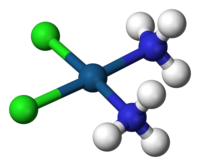
Photo from wikipedia
The effects of para-substitution on the structural and electronic properties of four series of two-coordinate m-terphenyl Group 12 complexes (R-Ar#)2M (M = Zn, Cd, Hg; R = t-Bu 1–3, SiMe34–6,… Click to show full abstract
The effects of para-substitution on the structural and electronic properties of four series of two-coordinate m-terphenyl Group 12 complexes (R-Ar#)2M (M = Zn, Cd, Hg; R = t-Bu 1–3, SiMe34–6, Cl 7–9, CF310–12, where R-Ar# = 2,6-{2,6-Xyl}2-4-R-C6H2 and 2,6-Xyl = 2,6-Me2C6H3) have been investigated. X-ray crystallography shows little structural variation across the series, with no significant change in the C–M–C bond distances and angles. However, considerable electronic differences are revealed by heteronuclear nuclear magnetic resonance (NMR) spectroscopy; a linear correlation is observed between the 113Cd, 199Hg, and 1H (2,6-Xyl methyl protons) NMR chemical shifts of the para-substituted complexes and the Hammett constants for the R-substituents. Specifically, an upfield shift in the NMR signal is observed with increasingly electron-withdrawing R-substituents. Density functional theory (DFT) calculations are employed to attempt to rationalize these trends.
Journal Title: Organometallics
Year Published: 2022
Link to full text (if available)
Share on Social Media: Sign Up to like & get
recommendations!